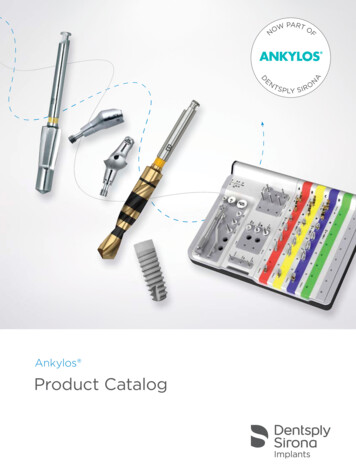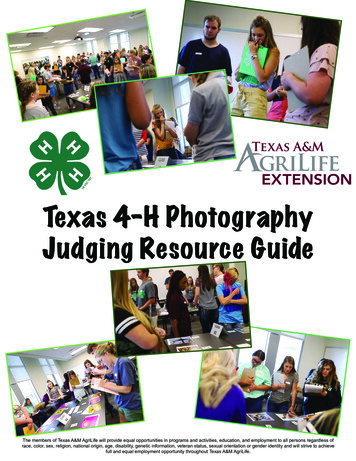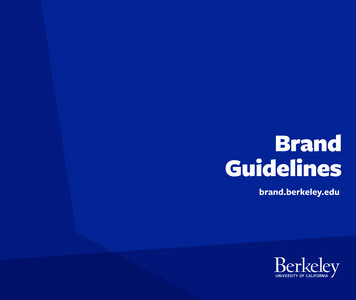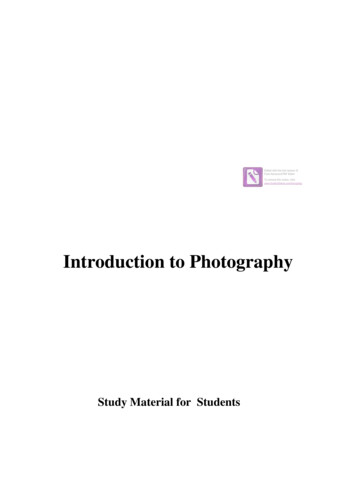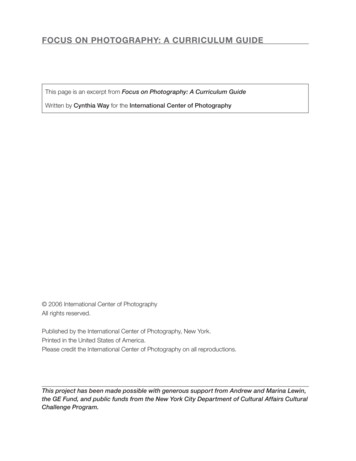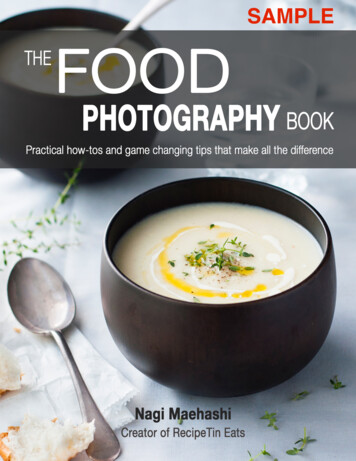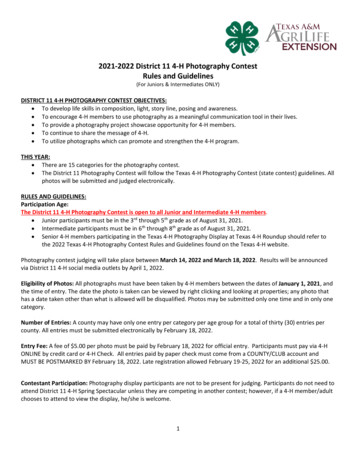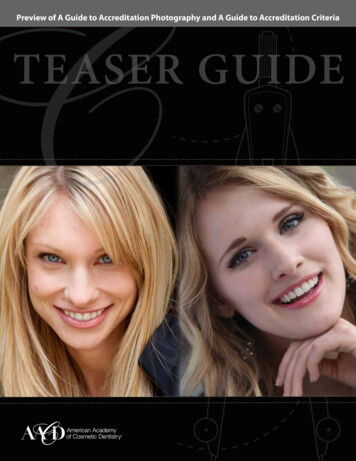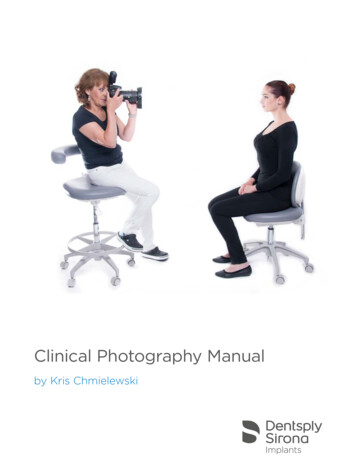
Transcription
Clinical Photography Manualby Kris Chmielewski
IntroductionDental photography requires basic knowledgeabout general photographic rules, but also properequipment and a digital workflow are important. Inthis manual you will find practical information aboutrecommended equipment, settings, and accessories.For success with clinical photo documentation,consistency is the key. The shots and views presentedhere are intended as recommendations. Whiledocumenting cases, it is very important to composethe images in a consistent manner, so that the resultsor stages of the treatment can easily be compared.Don’t stop documenting if a failure occurs. It’s evenmore important to document such cases because oftheir high educational value.Dr. Kris Chmielewski, DDS, MSc Educational Director of Dental Photo MasterAbout the authorKris Chmielewski is a dentist and professionalphotographer. Highly experienced in implantologyand esthetic dentistry, he has more than 20 yearsexperience with dental photography. He is also afreelance photographer and filmmaker, involved withprojects for the Discovery Channel.2
CONTENTEquipment4Camera5Initial camera settings for dental ctors15Mirrors16Contrasters17Camera & instrument positioning18Intraoral photographyRecommended settings22Frontal views23Occlusal views23Lateral views24PortraitsRecommended settings26Views27Post-production29How to prepare pictures for lectures and for print303
EquipmentEquipmentFor dental photography, you need a camera witha dedicated macro lens and flash. The equipmentpresented in these pages is intended to serve as aguide that can help with selection of similar productsfrom other manufacturers.4
Equipment CameraCameraThe best results can be achieved with a digital singlelens reflex (DSLR) camera. This type of camera hasinterchangeable lenses, providing great flexibility. Tochoose the proper body for dental photography,important elements to consider include size, weight,custom shooting modes, sensor type and size, built-inwireless controller, and manufacturer.Size and weightA mid-size camera is easy and comfortable to hold,even with one hand. The total weight will include thecamera, lens, and flash. Each of these components caninfluence the total weight.DSLR camera body with interchangeable lensCustom shooting modeThis option allows you to record and save the settingsthat are used most often. For dental photography,settings for capturing intraoral images can be savedso that the camera is always ready, no matter whois using it or when. Some cameras have more thanone custom shooting mode. This makes it possible torecord and save one mode for intraoral photographyand a second one for portraits. Some Canon camerashave three modes available. In Nikon models thereare two modes: U1 and U2. Please refer to yourspecific camera’s manual to go through the process ofrecording your favorite settings to the user modes.Two custom shooting modes: U1 and U2This manual reflects the author’s experience with certain camera brands and is not necessarily the opinion of Dentsply Sirona. The inclusionof these experiences does not constitute an endorsement, guarantee, warranty or recommendation of, and Dentsply Sirona make norepresentations and/or warranties about, any of the camera brands mentioned herein.5
Equipment CameraCameraDSLR Sensor – type and sizeWireless controllerIn general, DSLRs have one of two types of sensors:full-frame sensors or APS-C sensors. The first isbigger. A full-frame DSLR has a sensor that is thesame size as a frame of traditional 35mm film,measuring 36x24mm. The more popular APS-C sensorcameras have much smaller 22x15mm sensors. Thismeans a full-frame sensor has over 2.5 times thesurface area of an APS-C sensor.Some cameras have built-in wireless controllers. Thisfeature enables communication between the cameraand a wireless external flash without any additionalwires. The user only must set the communicationbetween the wireless flash and the camera.Both types can have the same number of pixels andresolution. The size of the pixels is crucial to imagequality. In dental photography, the difference in qualityof the final photograph is not recognizable.The advantage of a full-frame camera is mostlynoticeable in portrait photography with shallow depthof field. The advantage of an APS-C sensor is biggerdepth of field and lower price.Cameras that have built-in wireless controllers include:Nikon:D70, D70s, D80, D90, D200, D300, D300s, D7000,D7100, D7200, D600, D610, D700, D750, D800/D800E and D810.Canon:- Canon EOS 600D (Rebel T3i / Kiss X5)- Canon EOS 650D (Rebel T4i / Kiss X6i)- Canon EOS 700D (Rebel T5i / Kiss X7i)- Canon EOS 750D (Rebel T6i / Kiss X8i)- Canon EOS 760D (Rebel T6s / EOS 8000D)- Canon EOS 60D- Canon EOS 70D- Canon EOS 7D- Canon EOS 7D Mark IIManufacturerThe most common brands used in dental photographyare Canon and Nikon. The main reason for this istheir long presence on the photo market with a fullportfolio of cameras, lenses, flashes, and accessoriesused by both professionals and amateurs. New modelsare available every year, but used equipment is alsoavailable at reasonable prices. Other companies suchas Sony, Pentax, Sigma, Olympus, and others alsooffer some options but are not as common in dentalphotography.Full frame sensor size36 mm x 24 mmAPS-C sensor size22,5 mm x 15 mmDimensions of the full-frame and APS-C sensors.6Recommended camera bodies fordental photographyThese models have features that will help to makeyour dental photography an easy and pleasantexperience.APS-C Sensor:- Canon EOS 7D Mark II ,- Canon EOS 70D,- Nikon D7100- Nikon D7200Full Frame Sensor:- Canon EOS 6D- Nikon D750
Equipment Initial camera settings for dental photographyInitial camera settings for dental photographyWhen you buy the camera, you should get familiarwith your new equipment. The best approach is toread the manual carefully, but the reality is often verydifferent. Initial settings will influence managementof your files and the quality of the pictures. In themajority of camera models, access to these settings isachieved through the Menu.Here is the short list of the recommended settingsthat you should apply:Change color spaceto Adobe RGB S et correct date and time C hange color space to Adobe RGB I mage quality: RAW jpg (Canon),NEF jpg (Nikon) W hite balance: flash or 5500K I SO 200 M etering mode: evaluative metering (Canon),3D Matrix (Nikon) S elect single Auto Focus pointImage quality:RAW jpg (Canon),NEF jpg (Nikon)White balance:flash or 5500KSet correctdate and time ISO 2007
Equipment LensLensOn the market you can buy system macro lensessuch as Nikon and Canon (meaning that the lens andcamera are produced by the same company). Orlenses can be purchased from independent companiessuch as Sigma, Tamron, or Tokina. Lenses generallyare not inexpensive, but it should be possible to findone that will fit your budget.A few features to consider before buying the lens arethe desired focal length, magnification ratio, imagestabilization, and lens speed.Focal lengthIn photography we can differentiate between primelenses and zoom lenses. A prime lens has a fixed focallength and is described in mm.When you select the lens, please be aware that lensescan have different mounts. Before you buy your lens,make sure it has the connection that will fit yourcamera. Although a prime lens has only one focallength, it can come in lengths ranging from wide angleones through longer telephoto ones.A zoom lens has a range of focal lengths available tothe photographer in one lens; it is described as thefocal range in mm for instance: 70-200mm.Magnification ratioFor dental photography, the best lens is a macrolens with a magnification ratio of 1:1. This means thatwith minimum focusing distance, which is the closestdistance from the lens to the object to get a still sharpimage, you can capture a real life 1cm object with thesame size on your sensor. Be careful. While lenses withthe “macro” description can be found on the market,that doesn’t mean they always have a 1:1 magnificationratio.8Image stabilizationNewer lenses have built-in systems that cancompensate for image blur caused by small,involuntary movements known as camera shake.In dental photography, this feature doesn’t havea big impact because the shutter speeds varyin the range from 1/60 to 1/250 of a second. Ifyour lens has an image stabilization system, youshould read the lens manual carefully to know thecriteria for using it. These lenses are more expensive.Every company has a different acronym for imagestabilization (e.g. Nikon-VR, Canon-IS, Sigma-OS,Tamron-VC).Tip: when you shoot from a tripod, please switch offthe image stabilization mode on your lens to avoidblurry images. Otherwise your lens by default will tryto detect shaking and can give a false reading.Lens speedTwo features influence the so-called lens speed. Firstis the maximum lens opening described with theaperture number, such as f/2.8. This means that thespecific lens is not built to open more than the sizeof the aperture. The aperture number influences theamount of light that comes into the lens barrel andthe camera and, ultimately, how easy it is for you tolook through the camera’s viewfinder and see a brightimage that is easy to compose.Second is the auto focus speed. More expensivelenses have ultrasonic motors built-in. They allow forvery fast and accurate adjustment of the focus to geta sharp image when you are shooting in auto focusmode.
Equipment LensRecommended lenses for a Nikon DSLRcamera: N ikon AF-S VR Micro-NIKKOR 105mm f/2.8G IF-EDLensOther macro lenses available for a NikonDSLR camera: N ikon AF-S DX Micro NIKKOR 85mm f/3.5G ED VRLens S igma 105mm f/2.8 EX DG OS HSM Macro Lens forNikon T okina 100mm f/2.8 AT-X M100 AF Pro D MacroAutofocus Lens for Nikon T amron 90mm f/2.8 SP AF Di Macro Lens for Nikon T amron 90mm f/2.8 SP Di MACRO 1:1 VC USD Lensfor Nikon S amyang 100mm f/2.8 ED UMC Macro Lens forNikon R okinon 100mm f/2.8 Macro Lens for Nikon FRecommended lenses for a Canon DSLRcamera: C anon EF 100mm f/2.8L Macro IS USM Lens C anon EF 100mm f/2.8 Macro USM LensOther macro lenses available for a Canon: S igma 105mm f/2.8 EX DG OS HSM Macro Lensfor Canon EOS Cameras T amron 90mm f/2.8 SP Di MACRO 1:1 VC USD Lensfor Canon EOS T amron SP 90mm f/2.8 Di Macro Autofocus Lens forCanon EOSCanon EF 100mmf/2.8L Macro ISUSM Lens S amyang 100mm f/2.8 ED UMC Macro Lensfor Canon EF9
Equipment FlashFlashIn dental photography, flash is used to illuminate theoral cavity and the patient’s face. When choosing flashequipment, consideration should be given to the typeof flash, availability of a wireless option, and optionalaccessories.Flash typesFor dental applications, macro flashes arerecommended, especially for intraoral photography.Their construction allows the source of light to bepositioned close to the subject and the lens.A ring flash is mounted on the front of the lens withdedicated mount rings. It is available with wirelesscommunication.A dual flash is more advanced, and with the help ofadditional accessories like brackets it enables controlover the distance of the flash head from the lens.External flash is a very good choice for portraitphotography.Ring Flash10Dual FlashExternal Flash
Equipment FlashRecommendationsFor surgery, a ring flash is the topchoice. Its compact size and theposition of the flash tubes nextto the lens makes it possible toperfectly illuminate all the areas inthe limited space of the oral cavity.A dual flash can also be usedduring surgical procedures, butessential in this case is the closeposition of the flash heads next tothe lens axis. Such a position canbe set on the dedicated mountring for the specific flash models(Canon MT-24EX and Nikon R1C1)or with brackets.A ring flash has more limitationsfor documenting prostheticprocedures. The straight directionof the light creates a “flat” pictureflooded with light. The glossysurface of tooth enamel reflectsthe light, and the information onsuch a picture is limited (like color,transparency and texture). A betterchoice is dual flash on a bracket.By controlling the distance andflash head position, you can easilycapture many more details.Portraits – external flash withdiffuser11
Equipment FlashFlashRecommended flashes for CanonRing Flash C anon MR-14EX II Macro Ring Lite M etz 15 MS-1 Macro Ringlight (wirelessly controlledflash)List of Canon models with wireless controller built-in:- Canon EOS 600D (Rebel T3i / Kiss X5)- Canon EOS 650D (Rebel T4i / Kiss X6i)- Canon EOS 700D (Rebel T5i / Kiss X7i)- Canon EOS 750D (Rebel T6i / Kiss X8i)- Canon EOS 760D (Rebel T6s / EOS 8000D)- Canon EOS 60D- Canon EOS 70D- Canon EOS 7D- Canon EOS 7D Mark IIAll other Canon models need the Canon SpeedliteTransmitter ST-E2 to control the Metz flash.Canon MR-14EX IIMacro Ring LiteDual Flash C anon MT-24EX Macro Twin Lite Flash C anon Speedlite 270EX II. You need two of them bracket.If your camera doesn’t have a built-in wirelesscontroller, you will need a Canon Speedlite TransmitterST-E2.External Flash C anon Speedlite 600EX-RT C anon Speedlite 430EX IICanon Speedlite Transmitter ST-E2 with 2 Canon flashes 270EX II12Canon MT-24EXMacro Twin LiteFlash
Equipment FlashRecommended flashes for NikonRing Flash: M etz 15 MS-1 Macro Ring light Digital Flash(wirelessly controlled flash)Nikon models with a wireless controller built-ininclude:D70, D70s, D80, D90, D200, D300, D300s, D7000,D7100, D7200, D600, D610, D700, D750, D800/D800E and D810. If you have one of them, than youdo not need any other equipment to work with theMetz 15 MS-1 flash. Other camera models requireNikon’s SU-800 Wireless Speedlight Commander.Nikon D7100 withmounted Metz 15MS-1 flashDual Flash on the bracket: N ikon R1C1 Wireless Close-Up Speedlight SystemPortraits: N ikon SB-910 AF Speedlight N ikon SB-700 AF SpeedlightNikon R1C1 Wireless Close-Up Speedlight System mounted on thePhotomed bracket with LumiQuest Pocket Bouncers13
Equipment BracketsBracketsBrackets are used to mount the flash heads at adistance from the lens and camera body. The bracketis mounted to the tripod socket of the camera bodywith the fixing screw. The arms can be positioned invarious ways and enable control over the distance andangulation of the light source from the object and thelens.The most common suppliers on the market arePhotomed and Agno’s.When choosing a bracket, pay attention to thesystem compatibility. The mounts for Nikon flashheads SB-R200 and for Canon differ.Photomed bracketAgno’s bracket14
Accessories RetractorsAccessoriesAccessories for dental photography help to getbetter pictures. They include retractors, mirrors, andcontrasters. Because they come in contact with thepatient’s oral cavity, they all should be autoclavable.RetractorsRetractors are used to lift the lips away and givebetter access to the oral cavity. They can be made ofplastic or metal. Two main types exist: self-retractingretractors and single sided retractors. They come indifferent shapes and sizes.Self-retracting retractors are used mostly for frontalviews and also for occlusal shots.Single sided retractors are mostly used for lateralviews.RecommendationPlastic retractors are more comfortable for thepatients.Self-retractingretractorSingle sided retractor15
Accessories MirrorsAccessoriesMirrorsMirrors are used to capture the reflection of the teeth.They can be made from different materials and withdifferent techniques. The most common mirrors aremade of polished metal or glass coated with a highlyreflective surface. Depending on the surface coatingtype, a different reflection percentage will result.RecommendationBuy mirrors in different sizes to fit different individuals.For some mirror shapes, separate handles are offered.This is helpful in holding and positioning the mirror.A chromium coating reflects 65% of the light, rhodium75%, titanium 75%, and dielectric coatings suchas Ultrabright reflect 99%. All reflective surfaceswill scratch over the time; because of this, mirrorsshould be replaced from time to time. The coatingmaterial does not influence the final picture unless it isscratched or distorted. A less reflective surface needsmore energy from the flash to get a proper exposure.Chromium coated mirrors are most common and arecheaper than the others.Mirrors come in different shapes and sizes, howeverin daily practice, two shapes are used most often:occlusal and lateral.Occlusal mirrorLateral mirror16
Accessories ContrastersContrastersContrasters allow photos of the teeth to be takenwith a black background. They come in differentshapes and sizes. They are made from black anodizedaluminum or from metal plates covered with soft blacksilicone. Three types are available: anterior, occlusal,and lateral.RecommendationSelect contrasters coated with black silicone. It’s moredurable, will not scratch, and is more pleasant for thepatient. The anterior contraster is used most often.Anterior contrasterOcclusal contrasterLateral contraster17
Camera & instruments positioningCamera and instrument positioningCorrect positioning of instruments such as mirrors,retractors, and contrasters is very important for goodaccess and to avoid obstacles interfering with thephoto axis. Instruments can be held by the patientbut also by the assistant or photographer. To avoiddistortion of portraits and images of the teeth, thephoto/lens axis should be perpendicular to the teeth.Correct position of the photographer and the patient. The axis of the lens is at the eye level of the patient.18
Camera & instruments positioningPositioning of the camera forintraoral photography in the frontarea.The axis of the lens isperpendicular to the front teeth.Positioning of the anteriorcontraster for shooting upper frontteeth.19
Camera & instruments positioningPositioning of the anteriorcontraster for shooting lowerfront teeth.Positioning of the occlusal mirrorfor a lower occlusal photo.The camera axis is at a 45 angleto the surface of the mirror.20
Camera & instruments positioningExample of positioning the occlusalmirror for an upper occlusal archphoto.The camera axis is at a 45 angleto the surface of the mirror.Positioning of the buccal mirrorand retractor for a lateral/buccalview.21
Intraoral photography SettingsIntraoral photographyCamera and Flash SettingsCamera settings in Aperture Priority ModeMode:A (Aperture priority mode.In Canon it is described with theletters Av.In Nikon cameras, it’s with A.)Aperture f22 or higher – depends onthe construction of the lens.Shutter Speed: Will be set automatically by thecamera(in Nikon by default it is 1/60 of asecond; in Canon cameras you have tochange the Flash Synchronizationspeed in Av Mode to the fixed valueof 1/200th of a second).Flash setting: TTL mode (fully automatic mode –camera will measure and calculatethe proper amount of light for theexposure). With some of the flashes,Manual mode is necessary andrequires individual tests to determinewhich settings will be appropriate forthe final exposure.Camera settings in the Manual ModeMode:MAperture:f22 or higherShutter Speed: 1/200sFlash:Stay with TTL22
Intraoral photography ViewsFrontal viewsOcclusal viewsEquipment:Equipment: D SLR Camera set with 100mm macro lens and ringflash or dual flash D SLR Camera set with 100mm macro lens and ringflash or dual flashAccessories:Accessories: S elf-retracting retractor Self-retracting retractor A nterior contraster Occlusal mirrorAdvice:Advice: H old the camera with the back of the camera parallelto the plane of the front teeth. 4 5 degree angle between the mirror and the camerafor occlusal shot is recommended. F ocus on the front teeth. F ocus on the occlusal surface of the first bicuspids(premolars).Shots: R etracted view in the MIP position: upper and lowerteeth are in the full contact. Upper and lower teethare visible at least from first molar to first molar. R etracted view with teeth apart. U pper teeth from canine to canine(with and without contraster). L ower teeth from canine to canine(with and without contraster). F ull arch should be visible from the central incisorsto the mesial of the second molars. E liminate the fog on the mirror(air blow or heat the mirror).Shots: Full upper arch Full lower arch23
Intraoral photography ViewsLateral viewsEquipment: D SLR Camera set with 100mm macro lens and ringflash or dual flashAccessories: S ingle sided retractor B uccal mirrorAdvice: U pper and lower teeth should be visible from thecentral incisors to the mesial of the second molars. F ocus on the canine (cuspid) E liminate the fog on the mirror(air blow or heat the mirror)Shots: R ight lateral retracted view in the MIP position:upper and lower teeth are in full contact. R ight lateral retracted view with teeth apart:upper and lower teeth are not in contact. L eft lateral retracted view in the MIP position:upper and lower teeth are in full contact. L eft lateral retracted view with teeth apart:upper and lower teeth are not in contact.24
Intraoral photography ViewsUpper & lower teeth MIP position / retracted view Maxillary anterior teeth retracted viewMaxillary anterior teeth retracted view with contraster f 22, 1/200sf 22, 1/200sf 22, 1/200sUpper & lower teeth mouth open / retracted view Mandibular anterior teeth retracted viewMandibular anterior teeth retracted view with contrasterf 22, 1/200sf 22, 1/200sf 22, 1/200sMaxillary arch / occlusal view retracted view with mirrorRight lateral MIP viewretracted view with mirrorLeft lateral MIP viewretracted view with mirrorf 22, 1/200sf 22, 1/200sRight lateral open viewretracted view with mirrorLeft lateral open viewretracted view with mirrorf 22, 1/200sf 22, 1/200sf 22, 1/200sMandibular arch / occlusal view retracted view with mirror f 22, 1/200s25
Portraits SettingsPortraitsIn portrait photography, the main goal is to capturethe full face from the top of the head to the neck in3 basic positions: lips together, mouth open, and fullsmile. These types of pictures are used to analyze theesthetics and symmetry of the face.Camera and flash settingsMode: Aperture Priority Mode: A (Nikon),Av (Canon) or Manual (M)Aperture f11 Shutter Speed: will be set automaticallyby the camera in A/Av Mode. In Manual Mode, set thespeed to 1/200sFlash setting: TTL modeAuto Focus mode26
Portraits ViewsPortrait viewsEquipment: D SLR Camera set with 100mm macro lens andexternal flashAccessories: S olid/uniform background (black, white, or grey) F lash diffuserAdvice: F ull face from the top of the head to the neck P atient should look into the lens or straight ahead(in 45- and 90-degree positions) A uto focus on the eyeShots: F ront views in 3 positions (lips together, apart,and full smile) 4 5-degree views (left and right) in 3 positions(lips together, apart, and full smile) 9 0-degree views (left and right) in 3 positions(lips together, apart, and full smile)27
Portraits Views28Frontal view / not smilingFrontal view / mouth openFrontal view / full smilef/11, 1/200sf/11, 1/200sf/11, 1/200s45 right profile / not smiling45 right profile / mouth open45 right profile / full smilef/11, 1/200sf/11, 1/200sf/11, 1/200s90 right profile / not smiling90 right profile / mouth open90 right profile / full smilef/11, 1/200sf/11, 1/200sf/11, 1/200s45 left profile / not smiling45 left profile / mouth open45 left profile / full smilef/11, 1/200sf/11, 1/200sf/11, 1/200s90 left profile / not smiling90 left profile / mouth open90 left profile / full smilef/11, 1/200sf/11, 1/200sf/11, 1/200s
Post-productionPost-productionPost-production is the process that occurs aftertaking the photographs. It covers multiple actions likeimporting the pictures to the computer, managing thefiles, developing the pictures, adjusting the exposure,correcting the color, cropping, cleaning, and alsoexporting the files for different media.In dental photography it is very important to establisha digital workflow to help stay organized and maintaincontrol over file locations and security. For all of these,proper hardware and software is essential.One of the best software packages available onthe market for this purpose is Adobe PhotoshopLightroom. The software was created for photographers. Modules include Library, Develop, andsharing modes such as Slideshow, Book, and Print.Each of these modules is designed to meet thephotographer’s needs.In the Library Mode, you can organize your pictures,apply keywords, and organize other metadata. Anadvanced search engine is incorporated. This is a veryimportant tool for quickly finding specific picturesamong the thousands.The Develop Mode has all the necessary tools forcorrecting exposures, white balance, and color;cropping; cleaning up dust and scratches; and makingother improvements. One of the most importantfeatures of the Lightroom software is the way it treatsfiles. It is not destructive, meaning that when youdevelop your pictures, the software creates a recipe.It records all your actions, which are saved in thehistory. Permanent changes are applied to the picturewhen files are exported. But the original files remainuntouched, so you can always return to the originalfile in the file history.The software allows for working with different filetypes, including RAW, jpg, TIFF, psd, and png.29
How to prepare pictures for lectures and for printHow to prepare picturesfor lectures and for printThe size of the recorded picture is represented in thenumber of pixels (points). The pixel is the smallestsingle component of a digital image. Each pixel holdsinformation about color. The number of pixels in animage is sometimes called the resolution.Optimal image settings for print:The average sensor of digital cameras used in dentalphotography is close to 20 megapixels.For different media, images must be optimized toachieve the best results. Pictures should be prepareddifferently for lectures and for print. Compression: noneIf you are using dedicated software for photographylike Adobe Photoshop Lightroom, then the processis very easy. If not, the rules are the same and areapplied to the image during export. In that case, theinformation below can be used as a reference.File settings for TIFF: Format: TIFF (ask the editor or print house) Bit depth: 16 bits/component Color space: Adobe RGBFile settings for jpg: Format: .jpg Quality: 100 (best) Limit files size: unchecked (no limit) Color space: Adobe RGBOptimal image settings for lectures:File settings: F ormat: .jpg Q uality: 100 (best) L imit files size to 500kb C olor space: sRGBImage sizing: R esize to fit: long edge 2000 pixels D on’t enlarge R esolution: 72 pixels per inchOutput sharpening: Sharpen for screen A mount: high30Image sizing: Original size Resolution: 240 pixels per inchOutput sharpening: Sharpen for print for Matte Paper Amount: high
Notes
Notes
Notes
Notes
Dentsply Sirona does not waive any right to its trademarks by not using the symbols or . 32671374-USX-1708 2017 Dentsply Sirona. All rights reserved.About Dentsply Sirona ImplantsAbout Dentsply SironaDentsply Sirona Implants offers comprehensive solutionsfor all phases of implant therapy, including Ankylos ,Astra Tech Implant System and Xive implant lines, digitaltechnologies, such as Atlantis patient-specific solutions andSimplant guided surgery, Symbios regenerative solutions,and professional and business development programs, such asSTEPPS . Dentsply Sirona Implants creates value for dentalprofessionals and allows for predictable and lasting implanttreatment outcomes, resulting in enhanced quality of lifefor patients.Dentsply Sirona is the world’s largest manufacturer ofprofessional dental products and technologies, with a 130-yearhistory of innovation and service to the dental industry andpatients worldwide. Dentsply Sirona develops, manufactures,and markets a comprehensive solutions offering includingdental and oral health products as well as other consumablemedical devices under a strong portfolio of world class brands.As The Dental Solutions Company , Dentsply Sirona’s productsprovide innovative, high-quality and effective solutions toadvance patient care and deliver better, safer and fasterdentistry. Dentsply Sirona’s global headquarters is located inYork, Pennsylvania, and the international headquarters is basedin Salzburg, Austria. The company’s shares are listed in theUnited States on NASDAQ under the symbol XRAY.Visit www.dentsplysirona.com for more informationabout Dentsply Sirona and its products.THE DENTALSOLUTIONSCOMPANY
photography. Recommended camera bodies for dental photography These models have features that will help to make your dental photography an easy and pleasant experience. APS-C Sensor: - Canon EOS 7D Mark II , - Canon EOS 70D, - Nikon D7100 - Nikon D7200 Full Frame Sensor: - Canon EOS 6D - N
